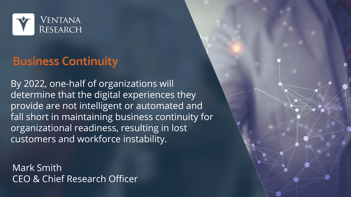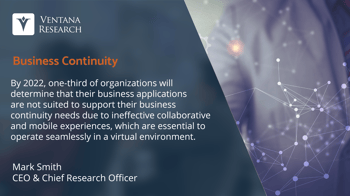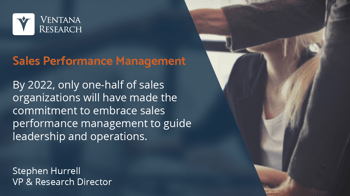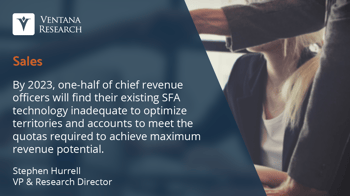The Business Continuity Imperative: The Selling Experience and Sales Performance Agenda
Sales plays a lead role in the revenue and growth of every organization. Whether the selling is direct or indirect, what happens in the sales department has ramifications that are perilous to underestimate. The imperative to maintain business continuity becomes painfully clear in a global pandemic, and that imperative demands that organizations cultivate sales excellence. This effort should start with leadership and engage sales operations, management and professionals with the objective of building customer relationships that can survive the test of time. The health of a sales organization hinges on an effective selling experience, and this requires technology investments that enable leaders to not just manage sales performance but help inspire it every single day.
Building Sustainable Success
Organizations should begin by assessing the short- and long-term business impact of all sales engagement efforts as well as how the selling experience is linked to sales performance. It is important to go beyond traditional sales enablement and examine the extent to which the sales experience encourages engagement that bolsters sales performance. Organizations require better intelligence and more streamlined automation in the selling process and leading vendors have responded with a new and modern set of applications and technology designed to enable virtual and digital selling that’s aligned to support sales.
A sales organization’s relationship with its customers will continue to determine its success in the months and years ahead. And building connections and relationships with today’s customers is impossible without high-quality, seamless digital experiences. In fact, Ventana Research asserts that by 2022, one-half of organizations will determine that the digital experiences they provide are not intelligent or automated and fall short in maintaining business continuity for organizational readiness, resulting in lost customers and workforce instability.
customers and workforce instability.
Sales success is about more than just attaining quarterly or annual quotas — it’s about sustainability and a sales team’s ability to operate under pressure over time and rise to the demands of business continuity. A selling experience imperative unifies an organization’s efforts to ensure sustainability through the best and worst of times, and should provide continuity and engagement that exceeds buyers’ expectations at every interaction. Optimizing the selling experience is more than just a nicety; it’s essential for every organization that looks to optimize sales engagement and customer relationships.
Streamlining lead-to-close efforts with sales enablement tools and applications such as contract, price and quote (CPQ) and contract lifecycle management (CLM) does not by itself mean a sales organization is enabling a superior selling experience. Organizations require more effective sales enablement, which is why we assert that by 2022, one-half of sales organizations will lack an effective selling environment to motivate buyers to collaborate on purchasing products and services. The challenge with the majority of sales organizations is understanding which sales enablement technologies go beyond automation and efficiency improvements to improve the experience and guide more effective engagement.
In cases where the product can be visualized, extended reality (XR) technology can virtualize and augment the buying and selling experience, significantly enhancing engagement and often answering their questions without losing valuable time on a phone call. Using this digital technology can also be essential as it should be integrated with CPQ and digital commerce systems to streamline access and decrease time to gaining the confidence from the buyer.
In times of crisis such as the current global health pandemic, when business continuity is a top priority, organizations mustn’t neglect the selling experience, especially if it has not previously been a focal point of sales leadership or the executive team. The selling experience is not just about tools and processes that improve sales’ efficiency but management that supports the sustainability of sales performance. How sales leadership manages quotas and territories can establish the tone of the relationship with the sales team and can have profound impact on individuals’ ability to reach goals and earn incentives.
continuity is a top priority, organizations mustn’t neglect the selling experience, especially if it has not previously been a focal point of sales leadership or the executive team. The selling experience is not just about tools and processes that improve sales’ efficiency but management that supports the sustainability of sales performance. How sales leadership manages quotas and territories can establish the tone of the relationship with the sales team and can have profound impact on individuals’ ability to reach goals and earn incentives.
Clear Communication is Key
Challenges such as a global pandemic demand active dialogue and clear communication across the sales organization, however, crises often have the opposite effect. Ad-hoc communications about changes in strategy or incentives and discounts are easily misinterpreted and can hamper effective management and sales operations. Furthermore, working out of a home office with limited outlets and otherwise routine after-work and weekend activities can challenge the mental health of any worker, including a seller. To maintain confidence and trust in the organization, sales leadership and managers must communicate goals and changes in strategy with this context in mind. Carrying on as if business is usual or, worse, sending haphazard and unclear communications will severely diminish chances of success.
To operate effectively sales organizations must be able to provide digitally secure and open communications to collaborate with buyers and potential customers on products and services. Ineffective communication creates friction that can lead to frustration, especially when the applications do not seamlessly support mobile technology. Sales organizations must ensure their communications and applications provide mobile experiences that help support sales interactions with buyers. We assert that by 2022, one-third of organizations will determine that their business applications are not suited to support their business continuity needs due to ineffective collaborative and mobile experiences, which are essential to operate seamlessly in a virtual environment.
Engaging a sales organization in new, virtual ways is essential to enacting selling methods that best represent the organization’s values and optimize interactions with buyers and potential customers. While it’s important that an organization rally its sales efforts during a crisis such as a pandemic, trust in a sales organization is based on sincere interactions and a sales organization’s ability to deliver continuous value. This requires more than simply increasing the velocity of communications. To be effective, an organization should establish best practices and policies that guide selling experiences and interactions with buyers — whether the relationship is direct or indirect. Applications and systems must enable communications outside of normal operations. And importantly, sales organizations should engage in active coaching and measure the experience at every buying touchpoint by soliciting feedback and monitoring sales to accurately determine challenges and opportunities.
Experiences Matter
Many organizations have managed to optimize their direct and indirect sales by focusing more on the sales process and less on the selling experience and performance outcomes. It’s important that an organization make investments into better supporting digital interactions with buyers, from emails and calls to meetings and pipeline creation. However, these efforts are rarely differentiators that create opportunities for breakthrough growth compared to productivity improvement. Sustainable growth is only possible when the organization goes beyond sweet talk to demonstrate to buyers and potential customers value in what’s possible. The seller-buyer relationship is not a “one-and-done” situation; an organization must foster memorable interactions and meaningful digital engagement. This approach requires that organizations examine the buyer’s experience with the seller and, just as important, can help organizations better understand and optimize the product experience with a modern product information management system.
Organizations should prioritize investments that will yield continuous insights on the buyers sentiment. Namely, if an organization is unable to capture and monitor interactions and feedback from sellers and buyers, then it’s probably missing the insights they require to effectively coach the sales team and improve performance. Continuous feedback from sales and buyers provides visibility into the dynamics that determine an organization’s revenue potential. Sales organizations should seek to establish a Voice of the Sales (VoS) program with a set of processes and technology that uses sales feedback and sentiment along with analytics and machine learning to help them better understand and optimize sales performance.
VoS processes and applications provide insight into actual selling experiences using feedback across every interaction to guide improvement. Furthermore, sales organizations that lack a quality VoS program demonstrate a lack of commitment to — and investment in — the buying and selling experience. Buyers provide the most honest feedback at the time of the interaction and a failure to capture these sentiments significantly hinders an organization’s understanding of seller and buyer satisfaction and its effect on the overall customer experience. If your executive team looked at the feedback and sentiment from your sales team and buyers sharing their interactions on Glassdoor, would you be pleased with what they would have to say? Will your sales team share their negative selling experience sentiments with your organization and impact your employee experience? What is the impact to the future customer experience?
I outlined the importance of providing an excellent customer experience in a previous perspective on the mission of a customer experience program. It’s impossible to separate the customer experience from the selling experience, which in turn is inextricable from the selling experience. Merely stating a commitment to the selling experience is not enough to meet revenue expectations, let alone to establish mutual confidence in the sustainability of the sales organization. Similar to an organization’s roadmap for its products and services, a roadmap for placing more intelligence into buying and selling experiences for optimizing sales performance reflects an organization’s investments and priorities to ensure business continuity.
Smart Investments Matter
Organizations must consider whether investments in applications that support sales enablement — from providing insights to coaching and managing accounts, products and services — align to sales performance expectations. Investments should do more than automate tasks. We at Ventana Research assert that by 2022, one-half of sales organizations will plan to replace applications with more intelligent ones that manage and  optimize sales performance.
optimize sales performance.
Smart investment requires an effective assessment of an array of sales applications. An assessment should include the following questions:
- Do your sales applications enable leadership and operations to work closely with managers to coach and motivate sales professionals?
- Are you able to have digitally secure and open communications to collaborate between your sales professionals and the buyers and customers?
- Can you monitor and coach your sales professionals based on their actual conversations and experiences with buyers?
- Have you performed resiliency testing to ensure all sales applications and processes can operate efficiently in suboptimal conditions?
- Do you have optimal product information that is easily assembled for buyers?
- Are you able to collaborative and digitally configure and quote deals efficiently?
- Do you have the price management methods, not only to optimize deals to close but also to achieve revenue and margin targets?
- Can you intelligently reconfigure your territories based on sales potential and performance and potential scenarios based on resources in the future?
- Do you have the ability to assess your sales capacity and resources, and then plan to adapt and hire resources to maximize your sales territory potential?
A “no” answer to any of these questions indicates risk that could directly impact a sales organization’s revenue potential. Every organization, no matter the industry, the number of its customers or the size of its sales organization, has an opportunity to significantly improve the selling experience and sales performance.
Furthermore, sales applications should do more than just enhance the selling experience and provide insights into sales performance. It’s critical that an application enable sales leaders and managers to adequately plan for and adapt to changes in territory and quotas based on the capacity and resources available. This continuous exercise is a shared responsibility, and impossible to do without linking actuals to the plan to determine the impact of changes. Antiquated methods such as spreadsheets are clumsy, error-prone and not designed for modern, collaborative business processes. They are difficult to operate, diminish accountability and increase risk. It is critical that sales organizations, especially in times of duress, use business continuity as a driver to improve sales planning and intelligent use of analytics and thus examine their investments in sales performance management. We assert that by 2022, only one-half of sales organizations will have made the commitment to embrace sales performance management to guide leadership and operations.
Partner with Finance
It’s difficult to overestimate the importance of teamwork between sales and finance when it comes to the revenue potential and the sustainability of the sales organization. This focus on revenue has inspired the role of Chief Revenue Officer to look beyond just the direct sales organization at how an organization can monetize products and services, and even subscriptions, all of which can contribute to its financial performance. Smart finance organizations have developed revenue risk models that assess variables that can impact the sales organization’s ability to achieve plans, quotas and targets. A successful sales organization goes further, embracing collaborative and continuous planning for all aspects of sales, from the pipeline and forecast, quotas and territories to capacity and resources, compensation, commissions and incentives. Sales planning demands continuous refinement and seamless collaboration within and beyond sales that increases the potential in achieving sales performance goals.
A focus on revenue is the foundation of both finance and sales, but the “softer side” of the relationship with the sales organization is just as important for ensuring business continuity and a sustainable relationship between sales and finance as well as sellers and buyers. The CFO, finance and sales leaders must also actively engage with HR leadership to ensure recruitment and retention in the sales organization. Keeping top talent requires insights on benchmarked compensation and pay equity issues that, left unaddressed, could lead to negative sentiment through the sales organization and even publicly impacting recruitment efforts from tarnished reputation. Keeping good sales talent is essential but attracting new sales talent and optimizing onboarding and ramp time requires effective sales planning across your capacity and resources.
The CFO and finance leadership need to actively support sales and take time to examine potential improvements and investments. Success requires engagement, not just fulfilling requests for an update on projected sales forecasts or inputs to the plans. Similarly, past investments into SFA and CRM tools to aid selling and manage and pay on incentive plans are insufficient. For this reason, we assert that by 2023, one-half of chief revenue officers will find their existing SFA technology inadequate to optimize territories and accounts to meet the quotas required to achieve maximum revenue potential.
Unfortunately, finance often doesn’t adequately understand most of sales’  applications nor the value they provide, and these vendors have not done a great job marketing and selling their products to the office of finance. This should not be an impediment for finance, but an opportunity for sales leadership and operations to develop a working plan that unifies their efforts with common applications and systems that optimize the selling experience and enable sales performance management. And one that should include the intersection with price and revenue management that ensure maximum return from all sales efforts.
applications nor the value they provide, and these vendors have not done a great job marketing and selling their products to the office of finance. This should not be an impediment for finance, but an opportunity for sales leadership and operations to develop a working plan that unifies their efforts with common applications and systems that optimize the selling experience and enable sales performance management. And one that should include the intersection with price and revenue management that ensure maximum return from all sales efforts.
Sales and finance leaders must work more closely together than ever before and focus on not just the annual plan or quarterly quota levels, but the information, technology and processes the sales team uses every day of the year. Executive teams and boards of directors are responsible for ensuring investments into the selling experience and sales performance management that will support sales needs today and in the future.
Next Steps
If you are not sure how to approach improving the selling experience and sales performance through the lens of business continuity, there are specific steps that every organization should take, similar to the steps outlined in my perspective on the imperative for digital innovation in business continuity. The use of digital technologies to reinvent the selling experience — from the outside in and from the inside out — requires the right lens that can support business continuity and not distract from it, which can ensure a more comprehensive approach. Most organizations have realized this and are making it a priority to be more prepared. We assert that by 2022, after a decade of concerted efforts in digital transformation, one-half of organizations will not have established business continuity as an investment priority and will not be prepared to operate in a future pandemic or crisis, which will lead to increased operational risks.
To achieve business continuity, optimize underlying processes and technology for your sales organization along with the buyers and customers who they interact with. This can have an immediate impact on top- and bottom-line results and reflects the priority you place on your sellers. Once your organization has an effective program and processes with leadership committed to delivering an optimal selling experience, you can be assured that the relationship is built to last. Ensure that existing and future sales enablement investments are designed for the selling experience, not just for automation and efficiency.
Every sales-to-customer relationship matters, no matter what role it plays in your sales process and growth. The entire executive team — the CEO’s staff, the CMO, CFO, CIO, COO, CHRO and the Chief Revenue Officer — should be aware of the strategy and plans for optimizing selling experiences. Sales leadership needs to ensure they deploy sales performance management and the discipline it entails throughout the sales organization. The future of sales depends on the active involvement from finance and HR as they strive to optimize performance. Achieving this requires investment and active, working relationships between finance, HR and the chief sales or chief revenue officer.
Determining your path forward for 2020 and beyond requires an effective leadership strategy and an understanding of your sales organization and the technology for them sales that can sustain business continuity and truly provide an effective selling experience that’s focused on sales performance.
Regards,
Mark Smith

Mark Smith
Partner, Head of Software Research
Mark Smith is the Partner, Head of Software Research at ISG, leading the global market agenda as a subject matter expert in digital business and enterprise software. Mark is a digital technology enthusiast using market research and insights to educate and inspire enterprises, software and service providers.








